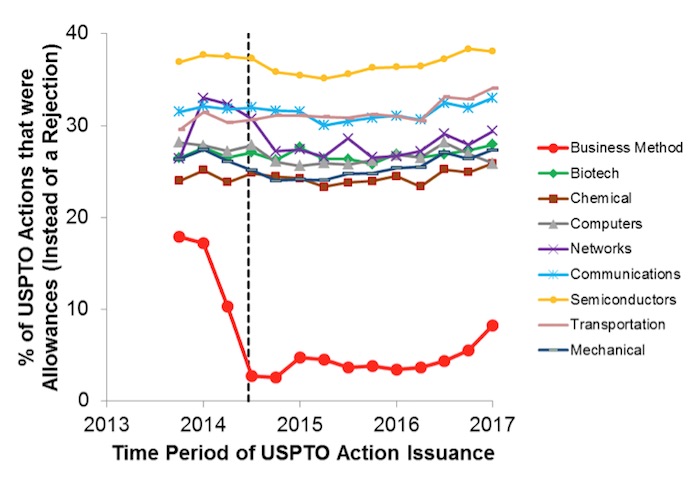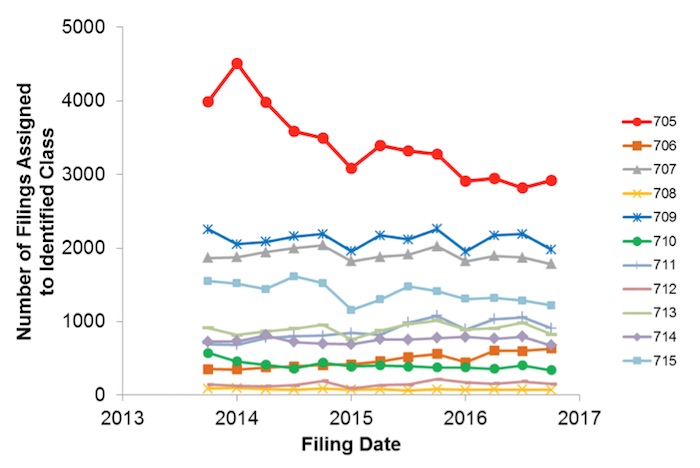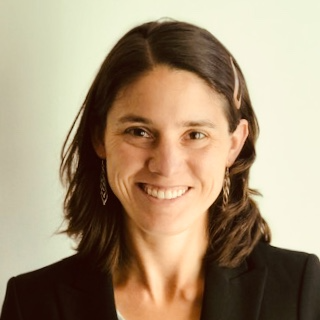 It is has been nearly three years since Alice Corp. v. CLS Bank has turned software patenting on its head. This decision has, in particular, wreaked havoc in the business method art units, where the statistical probability of securing a patent had been low (compared to other art units) even before the Supreme Court Alice decision. Afterwards, it was downright depressing: the probability that a PTO action was an allowance in these art units was in the low single digits – an order of magnitude lower than the probability in other art units. But, is the tide turning?
It is has been nearly three years since Alice Corp. v. CLS Bank has turned software patenting on its head. This decision has, in particular, wreaked havoc in the business method art units, where the statistical probability of securing a patent had been low (compared to other art units) even before the Supreme Court Alice decision. Afterwards, it was downright depressing: the probability that a PTO action was an allowance in these art units was in the low single digits – an order of magnitude lower than the probability in other art units. But, is the tide turning?
In the years after the Alice decision, it had seemed as though examiners in the business method art units felt as though their hands were tied with respect to issuing applications. Even if they had recommended an application for allowance, it was often sent back by quality review with an indication that a patent-eligibility rejection should be made or maintained. However, in early 2017 – at least with respect to a handful of applications – examiners’ perspectives seem to have changed, where they were more willing to work with the applicants to find eligible claim material and/or suitable arguments to be put on the record that would suffice for an allowance.
After experiencing and hearing about a number of these instances, we updated our data set from our earlier studies. Specifically, we requested data from the USPTO that would identify – for each quarter since Q4 2013, the number of allowances issued by each art unit in the quarter and the number of office actions issued by each art unit in the quarter. We grouped the data by Technology Center, though we sub-divided Technology Center 3600 into the business method art units (art units 3621-3629, 3681-3689 and 3691-3696) and other 3600 art units.
As expected, this data set similarly reflects our previously reported post-Alice plummeting of allowance prospects in the business method art units. However, we also observed a recent uptick in allowances in these art units. (See Figure 1.) The Q1 2017 portion of the PTO actions that were allowances was over 8.2%, as compared to 3.5% in Q1 2016. While the business method allowance prospects still remain substantially below those in other Technology Centers, the beyond-doubling of this statistic is of practical significance.

Figure 1
Why might this change have occurred? There are a number of potential explanations. For example, examination statistics may reflect review of applications filed post-Alice, which may have included specification detail and/or claim language tailored to address the current case law. Or perhaps case law has evolved to provide more avenues for applicants to argue (and/or amend) to arrive at a successful approach for addressing the Alice framework in the technology space. We believe that these are each likely contributing factors to the data.
However, beyond these, the change was aligned with a change in the Director for the majority of the business method art units. In approximately December of 2016, the position of the Director of the 3620s and 3680s art units was identified as vacant on the PTO’s Patent Technology Center Management page. (Business method art units include all of the 3620 and 3680 art units and 3691-3696.) In early 2017, the Director had been identified as Tariq Hafiz, who had previously been a Director of the 2620s, 2670s and 2690s in the Communications technology center. Thus, potentially, the new Director has influenced the process such that examiners are less dismissive of applicants’ subject matter eligibility.
Such a tide-change would be significant to applicants. Other data of ours indicates that applicants have been adapting their patenting strategies, such that there are substantially fewer (>25%) recent filings classified in the business method class (Class 705) as compared to the time periods pre-dating the Alice decision. (See Figure 2, which compares the number of filings in the business method class of 705 to other computer-related classes.) It remains an open question as to whether this decreased patent interest would translate into a decreased innovation/development interest.

Figure 2
We recognize that business method patents have experienced substantial scrutiny by the courts in a trend away from “no-tech” patents and functional claiming. One approach to respond to these decisions is to shut the gates and to essentially indicate that innovations unfortunate enough to be classified as a ‘business method’ (which includes innovations related to medical software, cryptography, anti-counterfeiting, fraud detection and electronic voting) are no longer patentable. However, the current case law still acknowledges that claims directed to software are not inherently abstract and can make “non-abstract improvements to computer technology just as hardware can”. Enfish LLC v. Microsoft (at page 11). Thus, another approach is to regroup to identify how applicants may draft claims and arguments in important applications that demand patent protection in order to secure protection in these technological spaces. It seems as though the new Director may be influencing this change in perspective, which may be responsible for traversing the allowance standstill that had been observed in the business method art units.

![[IPWatchdog Logo]](https://ipwatchdog.com/wp-content/themes/IPWatchdog%20-%202023/assets/images/temp/logo-small@2x.png)

![[Advertisement]](https://ipwatchdog.com/wp-content/uploads/2024/04/UnitedLex-May-2-2024-sidebar-700x500-1.jpg)
![[Advertisement]](https://ipwatchdog.com/wp-content/uploads/2024/04/Artificial-Intelligence-2024-REPLAY-sidebar-700x500-corrected.jpg)
![[Advertisement]](https://ipwatchdog.com/wp-content/uploads/2024/04/Patent-Litigation-Masters-2024-sidebar-700x500-1.jpg)

![[Advertisement]](https://ipwatchdog.com/wp-content/uploads/2021/12/WEBINAR-336-x-280-px.png)
![[Advertisement]](https://ipwatchdog.com/wp-content/uploads/2021/12/2021-Patent-Practice-on-Demand-recorded-Feb-2021-336-x-280.jpg)
![[Advertisement]](https://ipwatchdog.com/wp-content/uploads/2021/12/Ad-4-The-Invent-Patent-System™.png)






Join the Discussion
8 comments so far.
Mark Nowotarski
May 31, 2017 01:49 pm@B. I feel your pain. The 101 reversal rate at the PTAB is only about 15%. Best of luck at the CAFC!
B
May 30, 2017 11:06 pm” There is a significant (but not gigantic) number of reversals coming through.”
Hey, I just had the PTAB re-affirm a 101 rejection on the theory that the claims (1) could be performed by a generic computer; and (2) the claim included a mathematical algorithm.
I’m off to the CAFC hoping I’ll get a sane panel
Mark Nowotarski
May 26, 2017 03:04 pmGreat work Kate!
Another factor that may account for the increase in allowances is that the PTAB is finally handing down decisions for “Post Alice Appeals” (i.e. 101 rejections based on Alice). There is a significant (but not gigantic) number of reversals coming through.
Curious
May 26, 2017 01:32 pmthe beyond-doubling of this statistic is of practical significance
Oh yes, they went from a pittance of applications being allowed to a smidgen of applications being allowed. Either way, the prospects of getting a patent allowed in 3600 (business methods) is minuscule.
The USPTO still has a VERY LONG way to go.
Eric Berend
May 26, 2017 06:50 amAs an inventor whose invention properties shall now remain private and not subject to the induced fraud of the present patenting processes of the U.S. government, I have a different take on the state of affairs in the USPTO:
now that the vast majority of ‘patent troll’ individual inventors have been run out of town, the bureaucrats can get down to the business of approving applications of ONLY the so-called the “real innovators”, or $Billionaire $Corporations with SVP Gold-Plate Infringer Credentials.
The rest of us actual, real-world inventors, need not apply. U.S. Patents are exclusively for the benefit of $1,000,000,000’ionaires – and no-one else.
patent leather
May 25, 2017 09:26 pmThere’s another factor that could help explain the change. After Alice, many parties with “Alice”-type inventions were told by their attorneys to not even bother. So natural selection is at work and after Alice a “better” crop of applications were filed.
Miguel
May 25, 2017 01:17 pmJust for the sake of full context on the Director change in 3600, Director Hafiz was a long-time Business Methods SPE (I believe he was one of the first batch) before being promoted. His TC 3600 predecessor was a long-time SPE in a mechanical area (toilets, specifically)
So I’d attribute his predilection towards allowances as more of a philosophical difference, rather than one born from experience in TC 2600.
Night Writer
May 25, 2017 09:11 amMy experience is that there is a loosening of the ridiculous Alice rejections.